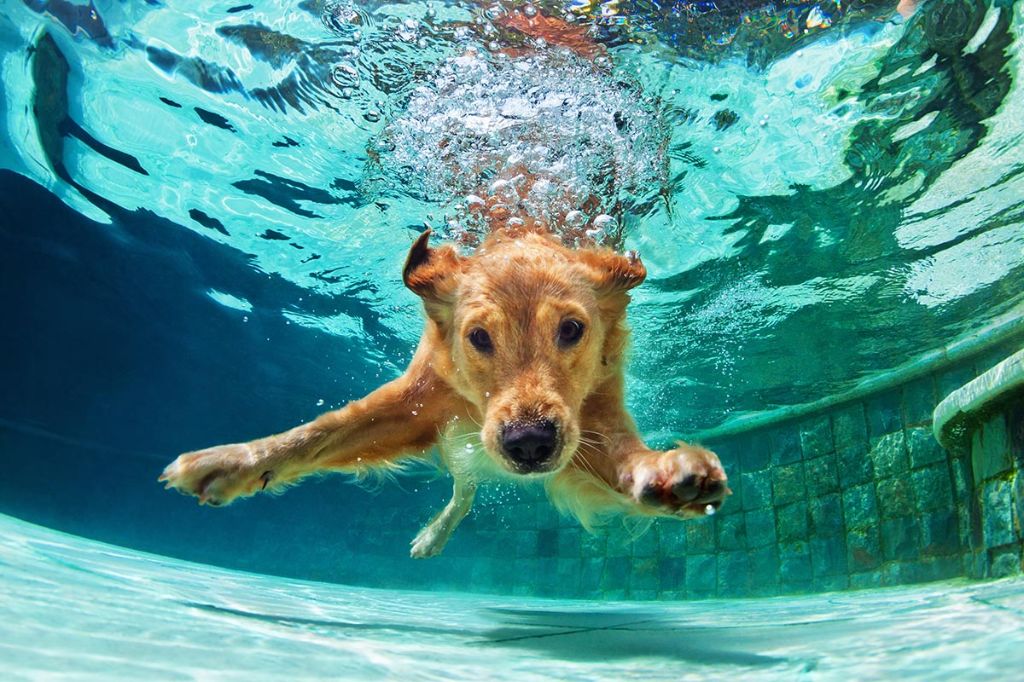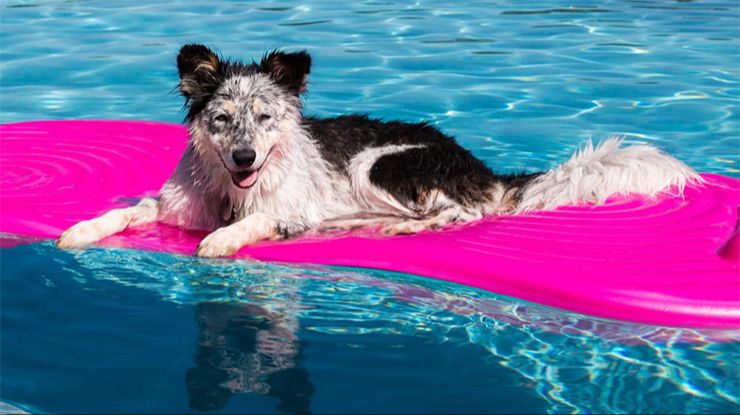Introduction
Swimming pools provide hours of fun and relaxation during the warm summer months. However, maintaining safe and sanitary pool water requires careful balancing of chemicals like chlorine and pH. Dog owners with pools often wonder if letting their furry friends take a dip will throw off these delicate chemical levels. In this article, we’ll explore the effects dogs can have on pool chemicals and water quality. We’ll also provide tips on preventing imbalances, fixing issues that arise, and keeping pools safe for both people and pets.
Background on Pool Chemicals
When starting up a new pool, there are three key chemicals that need to be properly balanced for clean and safe water:
Chlorine – Also known as pool shock, chlorine is used to sanitize the water and kill bacteria, viruses, and algae. Proper chlorine levels between 1-3 ppm help prevent issues like cloudy water, skin and eye irritation, and illnesses caused by germs. [1]
pH – The pH indicates whether the water is alkaline (basic) or acidic, and maintaining the proper pH between 7.4-7.6 ensures the sanitizer works effectively and equipment lasts longer. Improper pH can damage pool surfaces, cause eye irritation, and reduce chlorine’s disinfecting power.
Alkalinity – Also called total alkalinity, this refers to the level of alkaline compounds like carbonates and bicarbonates in the water. Proper total alkalinity between 80-120 ppm helps buffer the pH in a safe range and prevents corrosion or staining.

These chemicals work together to maintain clean pool water – chlorine destroys contaminants while proper pH and alkalinity provide the right environment for chlorine to work effectively. Monitoring and balancing these three chemicals is crucial for start-up and ongoing pool maintenance. [2]
[1] https://www.doheny.com/help/chemicals-explained
[2] https://premierpoolservice.com/chemicals-needed-for-pool-start-up/
Do Dogs Affect Pool Chemicals?
Yes, dogs can have an impact on pool chemicals. Their fur, drool, and urine can bring various contaminants into the water that affect chemical levels. According to Baracuda, dogs naturally carry dirt, leaves, pollen, and microorganisms on their fur that end up in the pool. The fur itself can also clog filters and pumps. Additionally, their drool contains bacteria and enzymes that consume chlorine. Dog urine has a high nitrogen content which raises pH and total alkalinity levels while also depleting chlorine.
Wastes like urine and drool drastically throw off chemical balances. The nitrogen in urine causes the pH to spike, and the enzymes in drool rapidly consume chlorine, leaving the pool vulnerable to algae growth and contamination. According to Blue Science, just a small amount of drool can deplete chlorine and create issues if not corrected quickly.
Specific Effects on Chemicals
Dogs can impact pool chemicals in a few key ways. Their fur and drool introduce organics that react with chlorine, forming irritating chloramines that deplete sanitizer levels (The Ultimate Guide: Should You Let Your Dog in the Pool?). Dog fur also sheds into the water, adding to the bather load and requiring more chlorine to stay balanced.
Another major effect comes from dog urine, which can raise pH and nitrogen levels in pool water (4 Things to Know Before Letting Your Dog in the Pool). The ideal pH for pools is between 7.4-7.6. Dog urine typically has a high pH around 9, which raises the overall pH of the pool. High pH decreases chlorine effectiveness and can produce cloudy water, scaly deposits, and eye irritation. Dog urine also introduces nitrogen-containing compounds like urea that require oxidation by chlorine.

Other Pet Impacts
While dogs are major culprits when it comes to messing with pool chemistry, they aren’t the only pets that can cause issues. Other domesticated animals like cats, birds, rodents, and reptiles can also negatively impact pool water if allowed access.
For example, cat and bird droppings contain ammonia which can throw off pH levels if they contaminate the pool. Shed fur and feathers can also clog filters and skimmers leading to poor circulation. Reptiles like turtles may carry salmonella bacteria in their feces which is a health hazard if introduced into pool water. Overall, it’s best to restrict all pet access to pools to prevent shedding, waste, and contamination that requires extra maintenance and chemical adjustment.
According to the CDC, diseases are not typically transmitted to humans from pet fur, feathers or waste in pools if chlorine levels are properly maintained between 1–3 ppm. However, as an extra precaution, immediate removal of any visible pet contaminants from the water is recommended. This helps ensure any potential germs are quickly neutralized by chlorine before swimmers are exposed.
In summary, while dogs pose the biggest risk for throwing off pool chemistry, wise pet owners will restrict access to pools by all domestic animals. This prevents unnecessary maintenance and health issues caused by contaminated water.
Preventing Imbalances
The best way to prevent your pet from throwing off your pool’s chemical balance is to keep them out of the pool when possible. Dogs and cats carry all sorts of dirt, oils, and other contaminants on their skin and in their fur that can get transferred into the water (PoolCentral). When pets enter the pool, these contaminants react with the chemicals like chlorine and cause imbalances. Limit your pet’s swimming to occasional supervised dips.
Before allowing your pet to take a swim, be sure to give them a good rinse or shower beforehand. Washing off loose hair, dirt, etc. will help reduce the contaminants they bring in. You may also want to brush your pet beforehand to remove excess fur (Aercmn).
It’s critical to maintain proper chlorine and pH levels in your pool at all times. Test the water daily and make adjustments as needed. The chlorine will help counteract some of the effects of pet contaminants. An ideal chlorine level is between 1-3 ppm (PoolMagazine). Shock the pool periodically to restore proper chlorine levels if they drop too low.
Fixing Imbalances
If you notice cloudy water, strong odors, or other signs your pool chemicals are off after your dog swims, there are a few steps you can take to restore balance:
Test and adjust chlorine and pH levels after pets swim. Use test strips or a testing kit to check the chlorine and pH and make adjustments as needed to maintain ideal levels (1-3 ppm chlorine, 7.4-7.6 pH). This helps prevent bacteria growth and contamination from pet waste.

Shock chlorinate if necessary. If test results show very low chlorine or high contaminants, a chlorine shock treatment may be required to get levels where they need to be. Make sure pets stay out of the pool during and after shocking until chlorine returns to a safe 1-3 ppm.
Regular filter cleanings. Frequently cleaning or backwashing cartridge filters, changing DE filters, or emptying canister filters removes pet hair, dander and other contaminants for cleaner water.
Pet-Safe Pool Care
For pet owners looking to ensure their pool water is safe for dogs and other pets, there are some alternative sanitizers and algaecides that can help create a pet-friendly environment:
Salt water pools utilize sodium chloride instead of harsh chlorine as the primary sanitizer. The salt is electrolyzed to create hypochlorous acid which kills bacteria but is much gentler on pets [1]. Mineral systems like those containing copper and silver ions can also sanitize pool water in a more pet-friendly way.
There are also algaecides specifically designed for pet pools. These use polyquad-based formulations that are safer for animals. Used in moderation, these types of algaecides can help prevent algae without irritating pets’ eyes, nose, and skin [2].
By switching to alternative sanitizers and more natural algaecides, pool owners can maintain water quality while keeping their furry friends safe and comfortable.
Pool Safety for Pets
It’s important to keep pet safety in mind when allowing dogs to swim in pools. The following safety tips can help prevent accidents and keep pets happy and healthy in the pool:

Don’t let pets drink pool water, as the chlorine and other chemicals can cause gastrointestinal upset or other health issues. Provide fresh, clean drinking water for pets away from the pool area. Limit their access to pool water as much as possible.
Monitor time spent swimming to avoid exhaustion, especially for elderly, very young, or small dogs. Take frequent breaks and watch for signs of fatigue like heavy panting or struggling to swim. Limit swimming sessions to 10-15 minutes at a time. according to 7 Pool Safety Tips for Pet Owners.
Consider a doggy life jacket for pets who are not strong swimmers or tire easily. This allows them to enjoy the pool safely. Choose a vest designed for buoyancy, not just warmth, according to 15 Pool Safety Tips for Dogs.
Never leave pets unsupervised around the pool. Keep gates closed and use alarms on doors to prevent accidental falls into the pool when unattended.
With some simple precautions, pool time can be safe and fun exercise for pets!
Conclusion
In summary, dogs can definitely impact pool chemicals due to factors like their hair, dirt, oils, urine, and other bodily excretions. This can throw off chemical balances like pH and chlorine levels, potentially making the water unsafe for swimming. While dogs don’t directly alter chemicals, their interactions with the water can reduce the effectiveness of chemicals like chlorine and stabilizer.
Monitoring chemical levels regularly is crucial for pet owners to stay on top of fluctuations and make adjustments as needed. Using enzyme products can help break down organics dogs introduce. Also practicing prevention like bathing dogs before swimming, keeping their nails trimmed, and rinsing off after use can minimize chemical disruption. Proper pool care enables safe swimming for both pets and people.